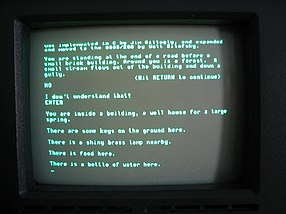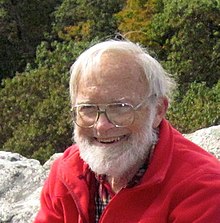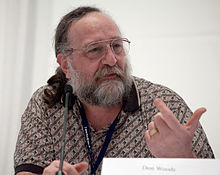Adventure (1976)
| Adventure | |
|---|---|
| A port of Adventure runs on an Osborne 1 . | |
| Senior Developer |
William Crowther , Don Woods |
| Erstveröffent- lichung |
Late 1975 or early 1976 |
| platform | various |
| genre | Text adventure |
| Game mode | Single player |
| control | keyboard |
| language | English |
Adventure (English for adventure ), also known as Colossal Cave Adventure known is a text adventure . It is generally considered to be the first computer game in the adventure category that gave it its name. It was programmed by William Crowther from 1975 and significantly expanded in 1977 by Don Woods .
action
The player has the task of exploring a cave system in which treasures are hidden, but also dangers lurk.
Game principle and technology
Adventure is a text adventure, which means that the environment and events are displayed as screen text and the actions of the player are also entered as text via the keyboard and processed by a parser . The parser understood simple commands , e.g. B. look("look") to look around, directions like east, westetc., to move from room to room, or get urn("take urn") to pick up the item "urn". For programming reasons, the recognition of objects was limited to the first five letters of the object name. In the input get silver("take silver") the parser therefore only recognizes "get silve", which made sense in terms of storage economy, but made the use of similarly named objects more difficult during design and programming.
The command XYZZYwas used in this game as a "magic word" to teleport as a shortcut between two places . It is therefore one of the first cheats in computer games. The term found its way into early hacker culture and was used as a reference in many other programs. The game Minesweeper uses the same combination with which you can display the hidden bombs.
Production notes
William Crowther, one at BBN Technologies busier computer and recreational cavers had originally a text-based program on the observance of the Mammoth and Flint Ridge cave system in the State of Kentucky written. In this program one could mostly just go from room to room and read the descriptions. The long-lost source code was found in an old backup in 2005. It was programmed in the Fortran IV programming language on a DEC PDP-10 computer, a minicomputer popular at the time, and was also known as ADVENT at the time, since file names could only contain six characters. Crowther expanded the program to include a game story with various, somewhat incoherent fantasy elements such as treasures, dwarves, a labyrinth and magic spells, in order to inspire his two daughters, from whom he was separated after a divorce, for a virtual tour of the cave system. The fantasy elements of the game were shaped by Crowther's experience with a Dungeons & Dragons role-playing group. In late 1975 or early 1976 he published the game in Arpanet , which he had helped develop as a BBN programmer. The exact publication date can no longer be reconstructed. In the following months he gradually expanded the game, but towards the end of 1976 he lost interest in further development.
In early 1977, Stanford University computer science student Don Woods came across Crowther's game on the university's network and decided to modify it. Since Crowther had left no reference to himself as the author in the game instructions except his surname, it was difficult to get in touch, especially since Crowther had meanwhile changed employers and worked for Xerox . Woods finally wrote an email to all 110 participants of the Arpanet at the time with the local section "crowther", which technically was the first documented spam mail in computer science history. Crowther received the mail and provided Woods with the source code. From March 1977 Woods expanded the game plot with various other elements such as a pirate, more mazes as well as a point count and a game goal, namely to get all the treasures. This original 350-point version of Adventure quickly spread through private copies via the Arpanet at the US universities and, according to estimates that were later expressed (not entirely taken seriously), cost around two weeks of working time per data center employee.
Extended versions were soon created, which are usually characterized according to the maximum number of points that can be achieved. The 430-point version published in August 1978 expanded the game to include five treasures as well as various rooms and puzzles and was developed by Woods himself. The 550-point version was probably the most common of these extensions.
Since only a few private people owned a computer at the time, the game was not commercially exploited. But it became the inspiration for the first commercial adventure adventure Adventureland (1978) designed by Scott Adams .
From mid-May 1977, Woods' expanded version attracted attention at MIT. In June 1977 there was a first version of Zork , a substantially revised program that was continuously developed. The Zork creators founded the company Infocom and from 1980 produced Zork versions, several successors and various other adventure games for home computers .
In 1979 a computer game of the same name was published for the Atari 2600 . However, this was a graphics-based game with an independent storyline, so no porting or implementation of the text-based adventure game .
Today Adventure is part of the BSD Unix distributions in the C port .
reception
Nick Montfort, professor of digital media at MIT , describes adventure as the archetype of the non-selective game genres text adventure and interactive fiction as well as a “great, original epic of interactive fiction”. Sarah Sloane, a lecturer in English at Colorado State University , pointed out that Adventure has set various genre conventions for digital fiction, such as the interface and navigation within the game world. For the US technology journalists and authors Steven Levy 's Adventure "is a metaphor for the program in itself": The wells, which can explore the cave, would find its counterpart in the machine-oriented levels with which you look at programming in assembler dealing , It is easy to get lost while playing adventure games or programming, and both of them are addicting. The British mathematician and Inform inventor Graham Nelson pointed out that in the five years after publication almost all adventures followed the game of Crowther and Woods and also offered an area to explore and collect a number of treasures as a game objective.
For Johannes Grenzfurthner (in his documentation Traceroute ) Adventure is a special example of intergenerational relationships. For him there is a direct connection from the slave Stephen Bishop, who created the first cave maps of the Mammoth Cave, to the programmer and cave enthusiast William Crowther, who wanted to develop a game after his divorce to be able to maintain a bond with his children. The computer game developer Roberta Williams , who was heavily influenced by Adventure and who worked as a woman in a male domain, "closes a historical arc of oppression, the will to discover, loss and creativity that is deeply rooted in the troubled history of the United States," says Grenzfurthner. "
Web links
- Adventure at MobyGames (English)
- Adventure in the Interactive Fiction Database (IFDB)
- The Colossal Cave Adventure page - Comprehensive page about playing with Woods' original sources of the 350-point and many other versions
- Colossal Cave Adventure (350-point version) in German (web application)
Individual evidence
- ↑ a b c d e f g Dennis G. Jerz: Somewhere Nearby is Colossal Cave: Examining Will Crowther's Original "Adventure" in Code and in Kentucky . In: Digital Humanities Quarterly . 1, No. 2, September 12, 2007.
- ↑ Rick Adams: Magic Word 'XYZZY'. Retrieved on August 23, 2020 (English).
- ↑ Nick Montfort: Twisty Little Passages - An Approach to Interactive Fiction . The MIT Press, Cambridge, Massachusetts 2003, ISBN 0-262-13436-5 , pp. 85 .
- ↑ Filfre.net: The Completed Adventure, Part 1. Retrieved December 12, 2016 .
- ^ Renga in Blue: Adventure (430 points) by Don Woods (1978). Retrieved June 1, 2017 .
- ↑ Nick Montfort: Twisty Little Passages - An Approach to Interactive Fiction . The MIT Press, Cambridge, Massachusetts 2003, ISBN 0-262-13436-5 , pp. 90 .
- ↑ Nick Montfort: Twisty Little Passages - An Approach to Interactive Fiction . The MIT Press, Cambridge, Massachusetts 2003, ISBN 0-262-13436-5 , pp. 119 .
- ^ Sarah Sloane: Digital Fictions: Storytelling in a Material World . Greenwood Publishing, Westport 2000, ISBN 978-1-56750-482-8 , pp. 58 .
- ↑ Steven Levy: Hackers: Heroes of the Computer Revolution . 25th Anniversary ed. O'Reilly Media, Sebastopol 2010, ISBN 978-1-4493-9380-9 , pp. 113 .
- ^ Graham Nelson: The Inform Designer's Manual . 4th edition. The Interactive Fiction Library, St. Charles 2001, ISBN 0-9713119-0-0 , pp. 347 .


